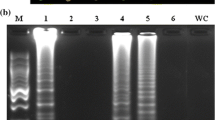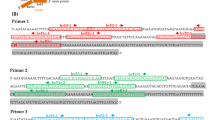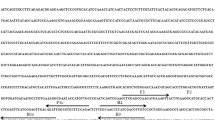Abstract
Strawberry is economically important. Anthracnose caused by Colletotrichum spp. has been a serious threat to this crop globally. To detect and distinguish latent Colletotrichum spp. infection on asymptomatic plants at an affordable cost is crucial for this disease control and the sustainability of strawberry industry. Loop-mediated isothermal amplification (LAMP) assay is superior for the higher sensitiveness, efficiency, and lower cost than other methods for pathogen diagnosis. In this study, six previously reported barcodes were evaluated against DNA templates from strawberry fungal pathogens including six Colletotrichum species and five beyond this genus, and further verified in 40 Colletotrichum isolates. Based on the discernibility revealed, a LAMP assay was developed for the diagnosis of Colletotrichum spp. by designing six primers recognizing the conserved regions in β-tubulin 2 gene from 13 Colletotrichum species of C. gloeosporioides and C. acutatum complexes. The specificity and accuracy of LAMP assay was tested against six Colletotrichum species of two complexes, with a detection sensitivity of 100 pg/μL genomic DNA. Current LAMP assay beginning with a 10 min plant lysis enabled a direct and quick diagnosis of Colletotrichum spp. in strawberry within one hour. Followed by PCR using primers specific to ApMat, Marker 2, and Marker 1, this assay could specifically differentiate Colletotrichum species, at least for the dominant species C. fructicola and C. siamense in China, realizing a diagnosis of latent infection at a species level. Current LAMP-PCR combined protocol allows for a sensitive and efficient detection and differentiation of latent Colletotrichum infection on strawberry, which will be useful for disease management and monitoring pathogen population.






Similar content being viewed by others
References
Azevedo-Nogueira F, Gomes S, Lino A, Carvalho T, Martins-Lopes P (2021) Real-time PCR assay for Colletotrichum acutatum sensu stricto quantification in olive fruit samples. Food Chem 339:127858
Buddie AG, Martinez-Culebras P, Bridge PD, García MD, Querol A, Cannon PF et al (1999) Molecular characterization of Colletotrichum strains derived from strawberry. Mycological Research 103:385–394
Cannon PF, Damm U, Johnston PR, Weir BS (2012) Colletotrichum – current status and future directions. Stud Mycol 73:181–213
Chung PC, Wu HY, Wang YW, Ariyawansa HA, Hu HP, Hung TH, Tzean SS, Chung CL (2020) Diversity and pathogenicity of Colletotrichum species causing strawberry anthracnose in Taiwan and description of a new species Colletotrichum miaoliense sp. nov. Sci Rep 10(1):14664
da Silva LL, Moreno HLA, Correia HLN, Santana MF, de Queiroz MV (2020) Colletotrichum: species complexes, lifestyle, and peculiarities of some sources of genetic variability. Appl Microbiol Biotechnol 104(5):1891–1904
Damm U, Cannon PF, Woudenberg JHC, Crous PW (2012) The Colletotrichum acutatum species complex. Stud Mycol 73:37–113
Damm U, Sato T, Alizadeh A, Groenewald JZ, Crous PW (2019) The Colletotrichum dracaenophilum, C. magnum and C. orchidearum species complexes. Stud Mycol 92:1–46.
Dean R, Van Kan JA, Pretorius ZA, Hammond-Kosack KE, Di Pietro A, Spanu PD, Rudd JJ, Dickman M, Kahmann R, Ellis J, Foster GD (2012) The Top 10 fungal pathogens in molecular plant pathology. Mol Plant Pathol 13(4):414–30
Edger PP, Poorten TJ, VanBuren R, Hardigan MA, Colle M, McKain MR, Smith RD, Teresi SJ, Nelson ADL, Wai CM, Alger EI, Bird KA, Yocca AE, Pumplin N, Ou S, Ben-Zvi G, Brodt A, Baruch K, Swale T, Shiue L, Acharya CB, Cole GS, Mower JP, Childs KL, Jiang N, Lyons E, Freeling M, Puzey JR, Knapp SJ (2019) Origin and evolution of the octoploid strawberry genome. Nat Genet 51(3):541–547
Freeman S, Katan T (1997) Identification of Colletotrichum Species responsible for anthracnose and root necrosis of strawberry in Israel. Phytopathology 87(5):516–521
Furuta K, Nagashima S, Inukai T, Masuta C (2017) Construction of a system for the strawberry nursery production towards elimination of latent infection of anthracnose fungi by a combination of PCR and microtube hybridization. Plant Pathol J 33(1):80–86
Gan P, Nakata N, Suzuki T, Shirasu K (2017) Markers to differentiate species of anthracnose fungi identify Colletotrichum fructicola as the predominant virulent species in strawberry plants in Chiba Prefecture of Japan. J Gen Plant Pathol 83:14–22
Goto M, Honda E, Ogura A, Nomoto A, Hanaki K (2009) Colorimetric detection of loop-mediated isothermal amplification reaction by using hydroxy naphthol blue. Bio Techniques 46(3):167–172
Han YC, Zeng XG, Xiang FY, Ren L, Chen FY, Gu YC (2016) Distribution and characteristics of Colletotrichum spp. associated with anthracnose of strawberry in Hubei. China. Plant Dis 100:996–1006
Hara-Kudo Y, Nemoto J, Ohtsuka K, Segawa Y, Takatori K, Kojima T, Ikedo M (2007) Sensitive and rapid detection of Vero toxin-producing Escherichia coli using loop-mediated isothermal amplification. J Med Microbiol 56(Pt 3):398–406
Jayawardena RS, Huang JK, Jin BC, Yan JY, Li XH, Hyde KD, Bahkali AH, Yin SL, Zhang GZ (2016) An account of Colletotrichum species associated with strawberry anthracnose in China based on morphology and molecular data. Mycosphere 7:1147–1163
Li Q, Shen D, Yu J, Zhao Y, Zhu Y, Dou D (2018) Rapid detection of Pythium aphanidermatum by loop-mediated isothermal amplification. Journal of Nanjing Agricultural University 41(1):79–87 (In Chinese)
Liu F, Wang M, Damm U, Crous PW, Cai L (2016) Species boundaries in plant pathogenic fungi: a Colletotrichum case study. BMC Evol Biol 16:81
Liu H, Xie WF, Zhang L, Valpuesta V, Ye ZW, Gao QH, Duan K (2014) Auxin biosynthesis by the YUCCA6 flavin monooxygenase gene in woodland strawberry. J Integr Plant Biol 56(4):350–63
Martínez-Culebras PV, Barrio E, García MD, Querol A (2000) Identification of Colletotrichum species responsible for anthracnose of strawberry based on the internal transcribed spacers of the ribosomal region. FEMS Microbiol Lett 189(1):97–101
Martinez-Culebras PV, Querol A, Suarez-Fernandez MB, Garcia-Lopez MD, Barrio E (2003) Phylogenetic relationships among Colletotrichum pathogens of strawberry and design of PCR primers for their identification. J Phytopathol 151:135–143
Mills PR, Sreenivasaprasad S, Brown AE (1992) Detection and differentiation of Colletotrichum gloeosporioides isolates using PCR. FEMS Microbiol Lett 98:137–144
Ning Z, Yi X, Lan W, Huang X, Zhang D, Dong L, Qian X (2019) Isolation and Identification of the Pathogen of Red Leaf Disease in “Sweet Charlie” Strawberry in Anhui Province. Molecular Plant Breeding 17(15):5051–5056 (In Chinese)
Notomi T, Okayama H, Masubuchi H, Yonekawa T, Watanabe K, Amino N, Hase T (2000) Loop-mediated isothermal amplification of DNA. Nucleic Acids Res 28:63e
O’Donnell K, Cigelnik E (1997) Two divergent intragenomic rDNA ITS2 types within a monophyletic lineage of the fungus Fusarium are nonorthologous. Mol Phylogenet Evol 7:103–116
Parikka P, Lemmetty A (2004) Tracing latent infection of Colletotrichum acutatum on strawberry by PCR. Eur J Plant Pathol 110:393–398
Prihastuti H, Cai L, Chen H, McKenzie E, Hyde KJFD (2009) Characterization of Colletotrichum species associated with coffee berries in northern Thailand. Fungal Divers 39:89–109
Quan PL, Sauzade M, Brouzes E (2018) dPCR: A Technology Review. Sensors (Basel) 18(4):1271
Rahman M, Ojiambo P, Louws F (2015) Initial inoculum and spatial dispersal of Colletotrichum gloeosporioides, the causal agent of strawberry anthracnose crown rot. Plant Dis 99(1):80–86
Ren XJ, Liang Y, Lu JP, Yang BR, Dai FM (2008) Identification of Colletotrichum spieces from strawberry in Shanghai. Acta Phytopathol Sinica 3:325–328 (In Chinese)
Silva DN, Talhinhas P, Várzea V, Cai L, Paulo OS, Batista DJM (2012) Application of the Apn2/MAT locus to improve the systematics of the Colletotrichum gloeosporioides complex: an example from coffee (Coffea spp.) hosts. Plant Pathol 104:396–409
Suzuki T, Tanaka-Miwa T, Ito Y, Uematsu S, Hirayama Y, Okayama K (2008) Development of specific PCR primers designed for the detection of Colletotrichum gloeosporioides causing strawberry anthracnose (abstract in Japanese). Jpn J Phytopathol 74:198
Tao G, Hyde KD, Cai L (2013) Species-specific real-time PCR detection of Colletotrichum kahawae. J Appl Microbiol 114(3):828–35
Wang NY, Forcelini BB, Peres NA (2019) Anthracnose fruit and root necrosis of strawberry are caused by a dominant species within the Colletotrichum acutatum species complex in the United States. Phytopathology 109(7):1293–1301
Weir BS, Johnston PR, Damm U (2012) The Colletotrichum gloeosporioides species complex. Studies in Mycology 73:115–180
White T, Bruns T, Lee S, Taylor J (1990) Amplification and direct sequencing of fungal ribosomal RNA genes for phylogenetics. PCR Protocols: A Guide to Methods and Applications. Academic Press New York pp:315-322
Wu JY, Hu XR, Zhang CQ (2019) Molecular detection of QoI resistance in Colletotrichum gloeosporioides causing strawberry anthracnose based on loop-mediated isothermal amplification assay. Plant Dis 103:1319–1325
Yang HC, Haudenshield JS, Hartman GL (2015) Multiplex Real-time PCR Detection and differentiation of Colletotrichum Species Infecting Soybean. Plant Dis 99(11):1559–1568
Yang J, Ding Z, Wang J, Tian S, Duan K, Gao Q (2021) Bet v 1 potential allergens are involved in anthracnose resistance of strawberry varieties. J Berry Res 11:21–32
Zhang LQ, Song LL, Duan K, Zhang L, Gao QH (2018) First report of Nectria pseudotrichia causing crown rot of strawberry in China. Plant Dis 102(8):1655
Zhang L, Song L, Xu X, Zou X, Duan K, Gao Q (2020) Characterization and fungicide sensitivity of Colletotrichum species causing strawberry anthracnose in Eastern China. Plant Dis 104(7):1960–1968
Zhao MZ, Wang J, Wang ZW, Qian YM, Wu WM (2012) Strawberry production and trade in the world. Fruit Grow Friend 6 (In Chinese)
Acknowledgments
This work was funded by Shanghai Municipal Agriculture Commission Project (Grant No. Hu Nong Ke Zhong Zi-2017-2-1). We are grateful to Dr. Jiayue Feng of Northwest A&F University for kindly sharing the genomic DNA of Podosphaera aphanis, Professor Kai Zhao of SAAS for valuable guidance in LAMP assay, as well as Professor Daolong Dou and Dr. Danyu Shen of Nanjing Agricultural University for critical discussion and suggestions. Thanks are due to anonymous reviewers for valuable comments which improved this manuscript.
Funding
This work was funded by Shanghai Agriculture Applied Technology Development Program, China (Grant No. Z201702) to Qinghua Gao.
Author information
Authors and Affiliations
Contributions
K. D. and Q-H. G conceived this work. Y. L. carried out most experiments and data analysis. Y. J. performed pathogen culture work. L-L. S., L-Q. Z., Y-C. H., and Z-Y. N. contributed to purification of all fungal isolates used in this work. W-Z. Y sampled diseased strawberry. Y. L. and K. D. prepared the manuscript. All authors contributed to revising and approved the manuscript.
Corresponding authors
Ethics declarations
Research involving human and animal participants
This research did not involve any human participants or animals.
Conflict of interest
The authors have no conflicts of interest to declare.
Additional information
Publisher's Note
Springer Nature remains neutral with regard to jurisdictional claims in published maps and institutional affiliations.
Supplementary information
Below is the link to the electronic supplementary material.
Rights and permissions
About this article
Cite this article
Liu, Y., Ji, Y., Han, Y. et al. Loop-mediated isothermal amplification and PCR combined assay to detect and distinguish latent Colletotrichum spp. infection on strawberry. J Plant Pathol 103, 887–899 (2021). https://doi.org/10.1007/s42161-021-00873-7
Received:
Accepted:
Published:
Issue Date:
DOI: https://doi.org/10.1007/s42161-021-00873-7




